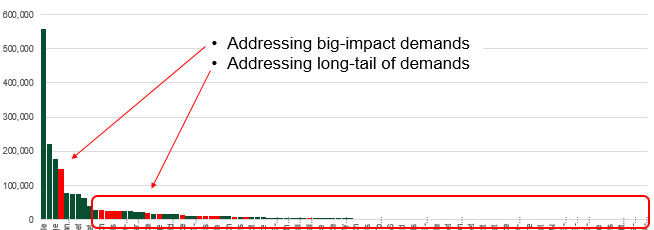Turn Incidents Into Resilience X-rays: Using Network Outages as Complexity Audits
After a major outage, we conduct PIRs (Post Incident Reviews). If we find something, we usually add controls. But when you think about it, that’s
The diagram below comes from an actual client’s functionality usage profile.
The x-axis shows the functionality / use-cases. The y-axis shows the number of uses (it could equally represent usefulness or value).
Each big-impact demand (ie individual bars on the left-side of the graph) warrants separate investigation. The bars on the right side (ie the long tail in the red box) don’t. They might be worth investigating if we could treat some/all as a cohort though.
The left side of the graph represent the functionality / use-cases that have been around for decades. Every OSS has them. They’re so common and non-differentiated that they’re not remotely sexy. Customers / stakeholders aren’t going to be wowed by them. They’re just going to expect them. Our product developers have already delivered that functionality, have moved on and are now looking for new things to work on.
And where does the new stuff reside? Generally as new bars on the right side of the graph. That’s the law of diminishing returns territory right there! You’re unlikely to move the needle from out there.
Does this graph convince you to send your most skilled craftsmen back to do more tinkering / disrupting at the left side of the graph… as opposed to adding new features at the right side? Does it inspire you to dream up exciting cohort management techniques for the red box? Perhaps it even persuades you to cull some of the long-tail features that are chewing up lifecycle effort (eg code management, regression testing, complexity tax)?
If it does convince you, don’t forget to think about how you’re going to market it. How are you going to make the left side sexy / differentiated again? Are you going to have to prove just how much easier, cheaper, faster, more efficient, more profitable, etc it is? That brings us back to the OSS proof-of-worth discussion we had yesterday. It also brings us back to Sutton’s Law – go to where the money is.
After a major outage, we conduct PIRs (Post Incident Reviews). If we find something, we usually add controls. But when you think about it, that’s
When you’re planning your next-generation OSS/BSS roadmap, what’s guiding your decisions? Are you looking for and/or researching features that have never been seen before? Are
According to Russ Hill, IBM had 27 top priorities in the 1990s, and only 3 of them aligned. Telcos today aren’t far off. The cost?
You’re in the business of OSS sales (we’re all in the business of OSS sales if we want to work on an OSS project). Your